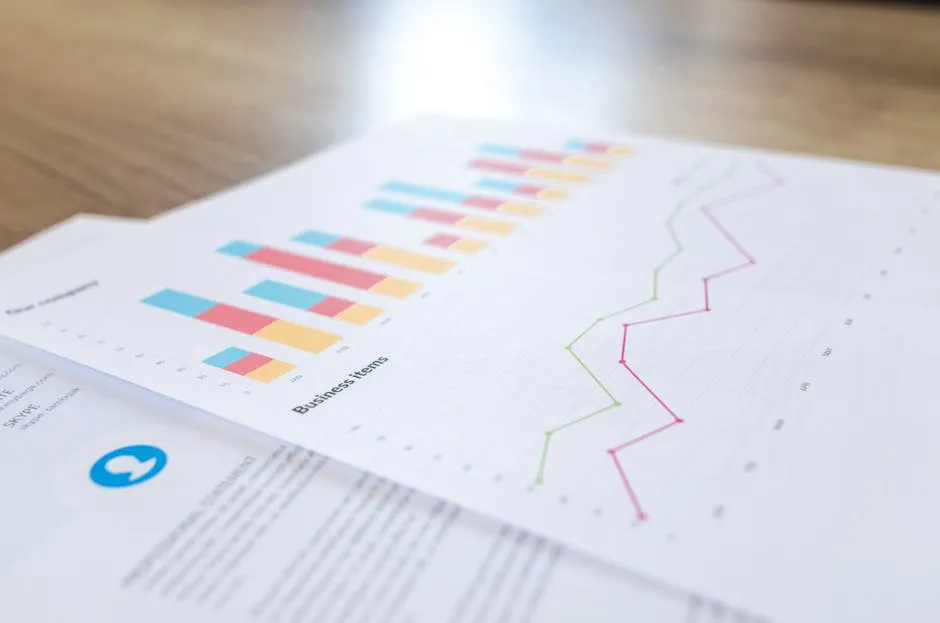Introduction
In the world of finance, the numbers tell a story, and statistical analysis is the key to interpreting that narrative. With the rise of big data, the demand for proficient analysis tools has never been higher. Enter R, the go-to programming language for statisticians and data scientists alike. This article will explore the vast landscape of statistical analysis of financial data using R, unraveling complex concepts and providing practical insights. Whether you’re a finance professional, a student, or just a curious mind, you’re about to embark on a data-driven journey that promises to enhance your analytical skills and deepen your understanding of financial markets.
R is not just a programming language; it’s a powerful tool designed for statistical computing. The language has gained a loyal following due to its versatile libraries and user-friendly syntax. With R, you can analyze stock prices, assess risks, and even forecast future market trends. The possibilities are endless! If you want to dive deeper into R, consider picking up R Programming for Data Science by Hadley Wickham. It’s a fantastic resource to get started!
Imagine you’re an analyst trying to make sense of stock market fluctuations. You sift through mountains of data, searching for patterns. R helps you visualize these patterns, turning numbers into captivating graphs. You can create stunning plots with just a few lines of code.
Statistical analysis in finance isn’t merely about crunching numbers. It’s about making informed decisions. You need to understand volatility, correlations, and other crucial financial concepts. R empowers you to model these factors, giving you a clearer perspective on market dynamics. For those looking to deepen their financial modeling skills, Financial Modeling by Simon Benninga is a must-read!
Let’s not forget about the importance of risk management. In finance, understanding risk is paramount. R provides tools to assess and mitigate risks effectively. From Value at Risk (VaR) calculations to stress testing, you can ensure that your financial strategies are sound and robust.
Throughout this article, we’ll guide you through the essential techniques of statistical analysis in finance using R. We’ll cover everything from exploratory data analysis to advanced statistical modeling. Each section will be packed with practical examples, ensuring you can apply what you learn right away.
So, whether you’re diving into R for the first time or looking to sharpen your skills, this guide has something for everyone. Get ready to unlock the secrets of financial data analysis and take your career to the next level. The world of finance is waiting for you, and R is your key to success!

Summary
This blog post will cover the intricacies of statistical analysis in finance using R, focusing on key areas:
- Understanding Financial Data: An overview of financial data types and their characteristics.
- Exploratory Data Analysis: Techniques for visualizing and summarizing financial data to uncover underlying patterns.
- Statistical Modeling: How to apply regression models, time series analysis, and risk management techniques using R.
- Practical Applications: Real-world examples and case studies demonstrating R’s capabilities in handling financial data.
- Advanced Techniques: Discussion on heavy-tailed distributions, copulas, and the application of machine learning in financial analytics.
By the end of this article, readers will be equipped with the knowledge and tools to perform statistical analyses on financial data, enhancing their skill set in both finance and data science. And for a deeper dive into data science concepts, Data Science for Business by Foster Provost and Tom Fawcett is highly recommended!
With R at your disposal, the financial world becomes an open book. Get ready to flip through its pages!

Understanding Financial Data
In the financial realm, data is the golden ticket. But what types of financial data are we talking about? Let’s break it down!
Types of Financial Data
Time Series Data
Time series data is like that annoying friend who keeps reminding you of past events—except in finance, it’s crucial! This type of data tracks the performance of financial assets over time. Think stock prices, interest rates, or exchange rates. The significance? It helps analysts and investors spot trends, seasonal patterns, and fluctuations. Understanding these patterns can lead to savvy investment decisions and risk management strategies. Remember, past performance is key to predicting future outcomes! If you’re keen on mastering this area, check out The Data Warehouse Toolkit: The Definitive Guide to Dimensional Modeling by Ralph Kimball.

Cross-Sectional Data
Cross-sectional data is the snapshot you take at a party. It captures a moment in time across various subjects—like different companies or assets. This type of data is vital for comparing financial performance. Investors and analysts utilize it to assess the health of companies within the same sector. Want to know how your favorite tech giant stacks up against its rivals? Cross-sectional data has the answers. It highlights differences and anomalies that can inform investment choices. For those looking to dive into practical applications, Python for Data Analysis by Wes McKinney is a fantastic resource!

Panel Data
Now, here comes the cool kid of data types: panel data. This data combines both time series and cross-sectional data. Imagine tracking multiple companies over several years. Panel data allows analysts to see how companies evolve over time while also comparing them. This richness enhances understanding of trends and relationships. It’s like having your cake and eating it too—who doesn’t want that?
Characteristics of Financial Data
Volatility
Welcome to the wild ride of volatility! This concept refers to the degree of variation in trading prices over time. High volatility can be thrilling—think potential for big gains—but it also brings risk. Investors must navigate this rollercoaster carefully. Financial models often incorporate volatility to forecast future price movements. Understanding volatility helps in making sound investment decisions and managing risk effectively. If you’re interested in financial analytics, consider exploring Financial Analytics: How to Use Data to Make Better Business Decisions by Michael J. Schuyler.

Heavy Tails
Heavy-tailed distributions sound ominous, right? They indicate that extreme outcomes (like market crashes) are more likely than a normal distribution would suggest. This characteristic is crucial in finance because it impacts risk assessment. When evaluating potential investments, analysts must account for these tail risks. Ignoring heavy tails could lead to catastrophic financial decisions. So, strap in and prepare for the unexpected!

Non-Normality
Ah, non-normality—the troublemaker of financial data. Most statistical methods assume a normal distribution. However, financial data often behaves differently, exhibiting skewness or kurtosis. This non-normality complicates analysis and predictions. Analysts must choose appropriate models that account for these behaviors. Techniques such as transformations or robust statistical methods can help manage these challenges. Remember, finance is not always a straight line; sometimes, it’s a winding road!
Understanding these elements of financial data is essential for anyone looking to make sense of the complex world of finance. With the right tools and insights, you can navigate this landscape like a pro—armed with R and a solid grasp of what makes financial data tick!

Summary Statistics
Mean, Median, Mode
Understanding mean, median, and mode is essential. They provide a snapshot of your data distribution.
Mean is the average. You find it by adding all values and dividing by the count. It’s sensitive to outliers. A few extreme numbers can skew it. For more insights on this concept, check out what does mean identically distributed in statistics.
Understanding the mean is crucial in statistical analysis. what does mean identically distributed in statistics
Median is the middle value. It’s great for understanding the center of your data, especially with skewed distributions. If you have an odd number of observations, it’s the middle number. If even, it’s the average of the two central numbers. For example, in the context of Poland, understanding the median salary can provide insights into economic conditions.
Exploring median statistics can reveal significant economic insights. statistics poland median salary 2024
Mode is the most frequently occurring value. It’s useful for categorical data. For example, if you’re analyzing a financial dataset of stock returns, knowing the most common return can inform your investment strategy. This is where understanding statsmodels residuals statistics can be beneficial.
The mode is critical for analyzing categorical data effectively. statsmodels residuals statistics
In finance, these statistics help summarize large datasets. They assist in identifying trends, making forecasts, and simplifying complex information. If you’re looking to enhance your knowledge, consider Statistical Modeling in a Data Science World by David G. Kleinbaum for comprehensive insights.

Standard Deviation and Variance
Standard deviation and variance measure risk. They help you gauge how much your data varies from the mean.
Variance quantifies how far a set of numbers is spread out. It’s calculated by taking the average of the squared differences from the mean. High variance indicates a wide spread of data points, suggesting greater risk.
Standard deviation is the square root of variance. It brings the measure back to the original units, making it easier to interpret. A higher standard deviation means more risk.
In finance, these metrics are crucial for portfolio management. They help investors assess the volatility of asset returns. Understanding these concepts allows you to manage risk more effectively. If you’re interested in financial modeling, Financial Modeling in Excel For Dummies by Danielle Stein Fairhurst is a great resource!

Practical Example
Let’s conduct exploratory data analysis on a sample financial dataset in R. We’ll analyze stock returns from a hypothetical company.
1. Load the necessary libraries:
library(tidyverse)
library(ggplot2)
2. Import the dataset (CSV file):
data <- read.csv("financial_data.csv")
3. View the first few rows of the dataset:
head(data)
4. Calculate summary statistics:
summary_stats <- data %>%
summarize(
mean_return = mean(Returns, na.rm = TRUE),
median_return = median(Returns, na.rm = TRUE),
mode_return = as.numeric(names(sort(table(Returns), decreasing = TRUE)[1])),
variance_return = var(Returns, na.rm = TRUE),
sd_return = sd(Returns, na.rm = TRUE)
)
print(summary_stats)
5. Visualize the distribution of returns:
ggplot(data, aes(x = Returns)) +
geom_histogram(binwidth = 0.01, fill = "blue", alpha = 0.7) +
labs(title = "Distribution of Stock Returns", x = "Returns", y = "Frequency")
6. Create a boxplot to identify outliers:
ggplot(data, aes(y = Returns)) +
geom_boxplot(fill = "orange") +
labs(title = "Boxplot of Stock Returns", y = "Returns")
This example showcases how to summarize financial data and visualize it using R. By understanding summary statistics, you’re better equipped to make informed financial decisions. And for those looking to enhance their understanding of financial risk, Risk Management in Finance: Six Sigma and Other Next-Generation Techniques by Anthony Tarantino is a solid choice!

Risk Management Techniques
Value at Risk (VaR)
Value at Risk (VaR) is a widely used risk management tool. It estimates the potential loss in value of an asset or portfolio over a defined period for a given confidence interval. In simpler terms, it tells you how much money you could lose, with a specific probability, in a set timeframe. Picture this: you’re at a casino, and VaR is like a security guard, telling you how much you should bet without losing your shirt.
Calculating VaR using R is straightforward. You can use the PerformanceAnalytics package, which provides functions for financial analysis. Here’s a basic example of how to calculate VaR:
library(PerformanceAnalytics)
# Simulated daily returns for a portfolio
set.seed(123)
portfolio_returns <- rnorm(1000, mean = 0.001, sd = 0.02)
# Calculate VaR at 95% confidence level
VaR_95 <- quantile(portfolio_returns, 0.05)
print(VaR_95)
In this example, we simulate 1,000 daily returns. The quantile function helps us find the 5th percentile, which represents our VaR at the 95% confidence level. If the result is -0.03, it means there’s a 5% chance of losing more than 3% in a day. If you’re looking for a deeper understanding of financial modeling, check out The Basics of Financial Modeling by John T. McDonald.

Stress Testing
Stress testing is another essential technique in risk management. It evaluates how a financial institution can cope with adverse market conditions. Think of it as a financial fitness test. Analysts simulate extreme scenarios, such as economic downturns or market crashes, to assess potential impacts on portfolio value.
Common methodologies for stress testing include scenario analysis and sensitivity analysis. Scenario analysis examines the effects of specific hypothetical events, while sensitivity analysis gauges how changes in input variables affect outputs.
In R, you can create stress test scenarios using a combination of statistical models and historical data. Here’s a simple example of how to conduct a stress test:
# Define a stress scenario: a market downturn of 20%
market_downturn <- -0.20
# Apply this scenario to the portfolio returns
stressed_returns <- portfolio_returns * (1 + market_downturn)
# Calculate the new VaR under stress
VaR_stressed <- quantile(stressed_returns, 0.05)
print(VaR_stressed)
In this code snippet, we simulate a 20% market downturn and observe its impact on our portfolio returns. This helps identify vulnerabilities and informs better risk management strategies. For those interested in financial forecasting, Financial Forecasting, Analysis, and Modelling: A Framework for Long-Term Forecasting by Michael A. Gallo is a valuable resource!

Practical Example
Let’s take a closer look at performing regression analysis and time series forecasting in R.
First, we’ll implement a simple linear regression model to analyze the relationship between two variables: years of experience (X) and salary (Y).
# Sample data
data <- data.frame(
years_experience = c(1, 2, 3, 4, 5),
salary = c(40000, 45000, 50000, 55000, 60000)
)
# Fit a linear regression model
model <- lm(salary ~ years_experience, data = data)
# Summary of the model
summary(model)
# Predicting salary for 6 years of experience
new_data <- data.frame(years_experience = 6)
predicted_salary <- predict(model, new_data)
print(predicted_salary)
This example creates a simple dataset, fits a linear regression model, and predicts the salary for someone with six years of experience. If you’re interested in advanced statistical techniques, consider checking out The Art of Statistics: Learning from Data by David Spiegelhalter.
Now, let’s forecast a time series. We’ll use the forecast package to analyze monthly sales data.
library(forecast)
# Sample monthly sales data
sales_data <- ts(c(200, 210, 220, 230, 240, 250, 260, 270, 280, 290), frequency = 12, start = c(2021, 1))
# Fit an ARIMA model
fit <- auto.arima(sales_data)
# Forecast the next 6 months
forecasted_values <- forecast(fit, h = 6)
# Plot the forecast
plot(forecasted_values)
In this code, we create a time series of monthly sales data and fit an ARIMA model using the auto.arima function. Finally, we forecast the next six months and visualize the results. For those looking to further their knowledge in business statistics, Business Statistics For Dummies by Alan Anderson is a great guide!

Conclusion
In the age of data-driven decision-making, mastering statistical analysis of financial data using R is a superpower. This article has served as your trusty guide, covering everything from the basics to advanced techniques. With R’s robust capabilities, finance professionals can reveal insights that lead to smart decisions and effective risk management.
Imagine having a magic wand that helps you navigate the tangled web of financial markets. That’s R for you! It simplifies complex data, turning chaos into clarity. As you embark on your analytical journey, remember: the key to success lies in practice and curiosity. Keep experimenting with different techniques and datasets. If you’re interested in financial investing, The Intelligent Investor by Benjamin Graham is a timeless classic.
Financial analysis isn’t just about crunching numbers; it’s about storytelling with data. Each dataset holds tales waiting to be uncovered. R equips you with the tools to tell these stories compellingly. Whether you’re analyzing stock trends or assessing risk, your analytical prowess will shine through.
Don’t shy away from challenges. Each mistake is a stepping stone toward mastery. As you grow more comfortable with R, you’ll find your confidence soaring. Dive into real-world datasets and apply your newfound skills. The financial world is dynamic and ever-changing, and your ability to adapt will set you apart. For those looking to learn more about risk management, Financial Risk Manager Handbook by Philippe Jorion is highly recommended!

FAQs
What is R, and why is it used for financial analysis?
R is a programming language designed specifically for statistical computing and data analysis. Its extensive libraries and user-friendly syntax make it a favorite among analysts in finance. R provides tools for data manipulation, visualization, and modeling—essential for uncovering insights from financial data. With R, tasks like data cleaning, statistical testing, and forecasting become straightforward, allowing analysts to focus on interpreting results rather than wrestling with code. Plus, the active community continuously contributes new packages, ensuring that R stays at the forefront of financial analysis.
Can I use R for large financial datasets?
Absolutely! R can handle large datasets, but performance may vary depending on your system’s capabilities. For optimal performance, consider using packages like `data.table` or `dplyr`, which are tailored for efficient data manipulation. Additionally, leveraging R’s capabilities with databases via packages like `RMySQL` or `RSQLite` can enhance your ability to work with extensive datasets. Remember, efficient coding practices and data management strategies are crucial for maintaining performance with large datasets.
Are there specific R packages for financial analysis?
Yes! Several R packages cater specifically to financial analysis. Here are a few popular ones: – `quantmod`: Ideal for quantitative financial modeling, providing tools for data retrieval, modeling, and testing strategies. – `TTR`: Focused on technical trading rules, this package helps calculate indicators like moving averages. – `rugarch`: Designed for univariate GARCH models, it’s invaluable for modeling financial time series volatility. These packages, among others, streamline various aspects of financial data analysis, making R a powerful tool in the finance sector.
How can I learn more about statistical analysis in R?
To deepen your knowledge, consider various resources. Books like “Statistical Analysis of Financial Data in R” by Renée Carmona offer comprehensive insights. Online platforms like Coursera, edX, and DataCamp provide interactive courses tailored to R and financial analysis. Additionally, engaging with communities on forums like Stack Overflow or R-bloggers can enrich your learning experience. Don’t forget to practice with real-world datasets to solidify your understanding!
What are some common mistakes to avoid when analyzing financial data in R?
When analyzing financial data in R, avoid these pitfalls: – Ignoring data quality: Always clean and preprocess your data. Outliers and missing values can skew results. – Overlooking assumptions: Many statistical models have assumptions. Ensure your data meets these before applying models. – Neglecting visualization: Visualizing data can reveal trends and patterns that raw numbers cannot. Use plots effectively to communicate insights. – Failing to validate models: Always test your models with out-of-sample data to ensure their reliability. By steering clear of these common mistakes, you can enhance your analytical skills and improve your financial analyses.
Please let us know what you think about our content by leaving a comment down below!
Thank you for reading till here 🙂
All images from Pexels




